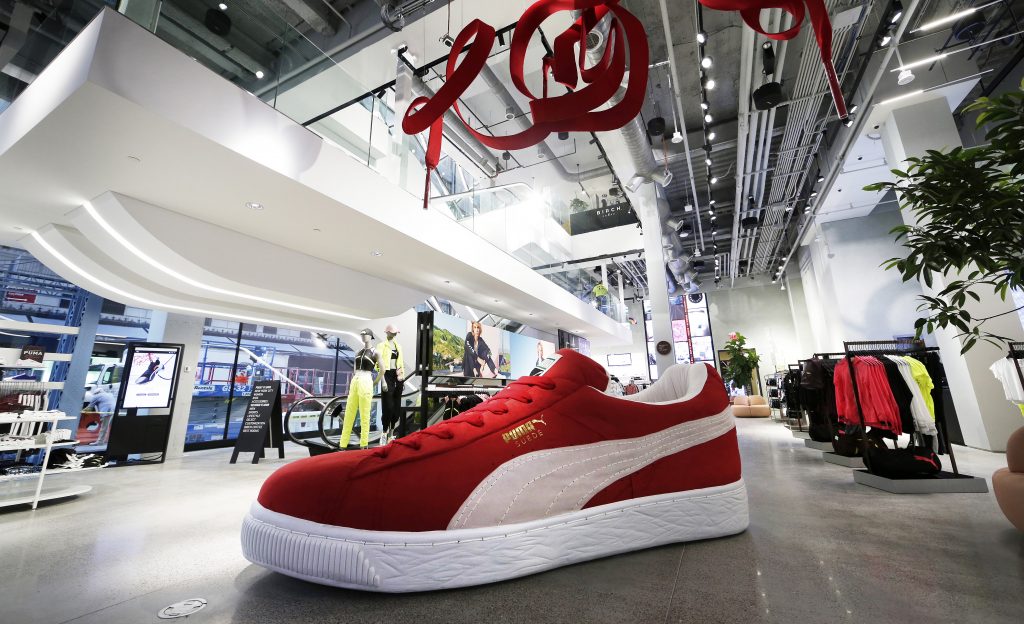By Thomas J. Ryan
<span style="color: #999999;">Looking to build on its recent momentum, Puma on Wednesday opened its first U.S. flagship in New York City. The 24,000-square-foot location stands out for its wide range of interactivity, including sports engagement zones, a massive customization studio and digitally-connected offerings.
In an interview at the store, Bjoern Gulden, CEO of Puma SE, told SGB the store’s aim is largely increasing the relevance of the Puma brand with consumers.
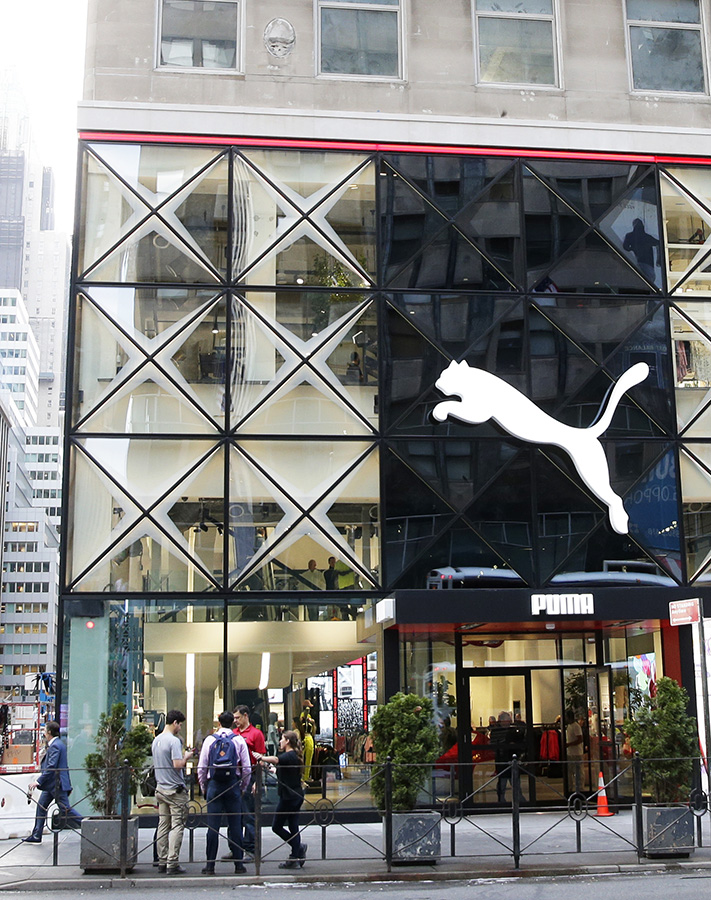 “You become relevant by talking to the consumer where the consumer is. So in today’s world, you talk to the consumer and the athlete in the stadium, on the pitch, on the court, on the track, and then digitally, said Gulden. But the real consumer who buys the product, you meet in the store. And that’s why, in digital times, it’s also important to talk to the consumer face to face.”
“You become relevant by talking to the consumer where the consumer is. So in today’s world, you talk to the consumer and the athlete in the stadium, on the pitch, on the court, on the track, and then digitally, said Gulden. But the real consumer who buys the product, you meet in the store. And that’s why, in digital times, it’s also important to talk to the consumer face to face.”
The store underscores Puma’s commitment to re-establishing itself as a major player in the North American market. The store also offers a “very global” reach with millions of tourists visiting New York City every year to support Puma’s global positioning, according to Gulden. He also believes the store will act like a “lab” in testing new techniques and strategies.
But the major goal is heightening relevance.
“I think that our global awareness is high but we also have to admit that other brands have done a better job than us,” said Gulden. “They’re much bigger and we have to become more relevant for the young consumer, the new consumers. And you do that by talking to them.”
The store, on the corner of Fifth Avenue and 49th Street, features 18,000 square feet of retail space spanning two floors, with state-of-the-art double-height storefronts across 160 feet of wraparound frontage.
Among the stand-out in-store features:
— Puma x YOU customization studio: Puma has partnered with renowned artists and designers to establish an expansive customization studio. Consumers can customize and personalize Puma footwear, apparel and accessories using paints, dips, dyes, patchwork, embroidery, 3D-knitting, laser printing, pinning, material upcycling, and many other creative mediums. In a partnership with Chinatown Market, the store will be hosting “Chinatown Market University” at the space beginning this weekend, where the NYC-based brand will help patrons customize gear using their handheld printer guns. New artist residencies with other artists will also visit every two weeks.
— Motosport Engagement Zone: The store stocks the only Formula 1 racing simulator in the world that lets gamers race down the streets of New York City. With coaching from Puma’s brand ambassador Lewis Hamilton and Aston Martin Red Bull Racing driver Max Verstappen, the car ends up racing through Central Park before reaching the finish line at the entrance of the Puma store.
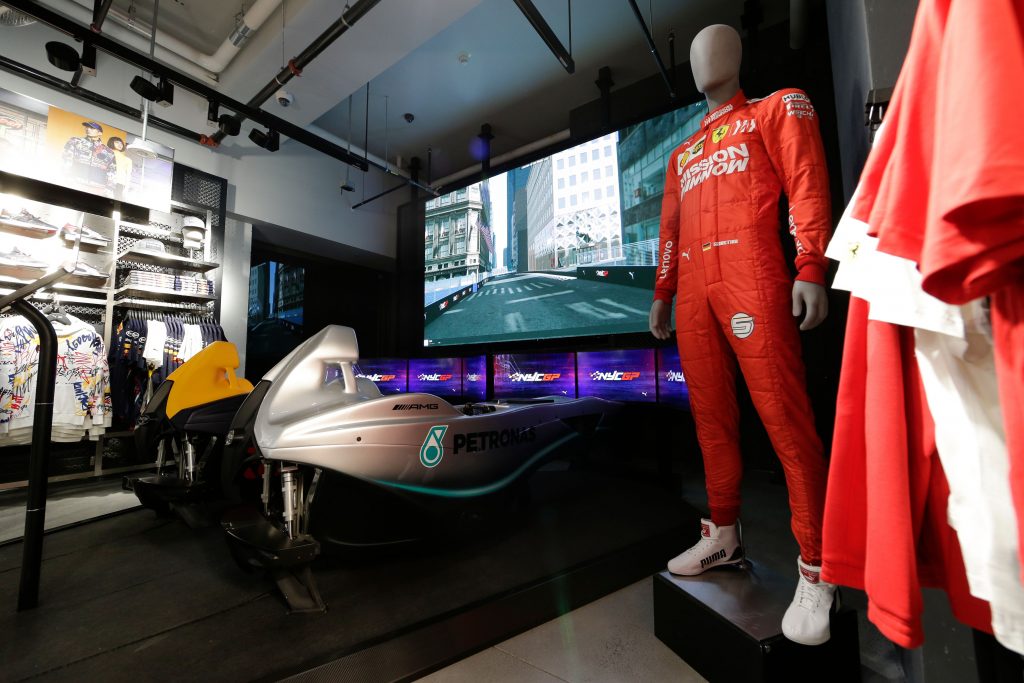
— Skillcube: In the team sports section, consumers can test the latest Puma boots on the in-store simulator that mimics the pitch of San Siro Stadium, the home of Puma-sponsored AC Milan. Players are virtually coached by Puma brand ambassadors and star footballers Antoine Griezmann and Romelu Lukaku.
— Magic Mirrors: Customers can view products in alternate colors and styles through ‘Magic Mirrors’ placed throughout the store. The mirror allows RFID product to bring up alternative selections based on the item the consumer tries on. Consumers can press a button to notify an associate they need help at the mirror and sign up for in-store events.
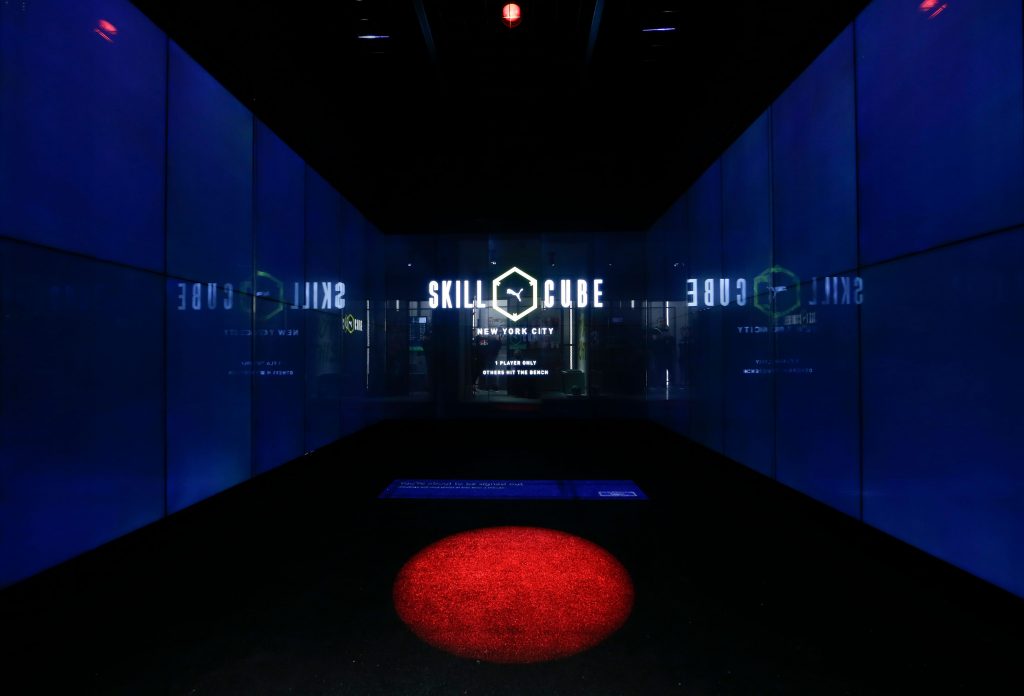
— NBA2K gaming/Augmented Reality: The basketball zone offers the stadium seating for a large-screen NBA2K gaming experience. The zone also features state-of-the-art technology including QR codes located on all products. A current augmented-reality feature enables consumers to pair their smartphones with the QR codes to interact and take selfies with the Puma The Cat mascot.
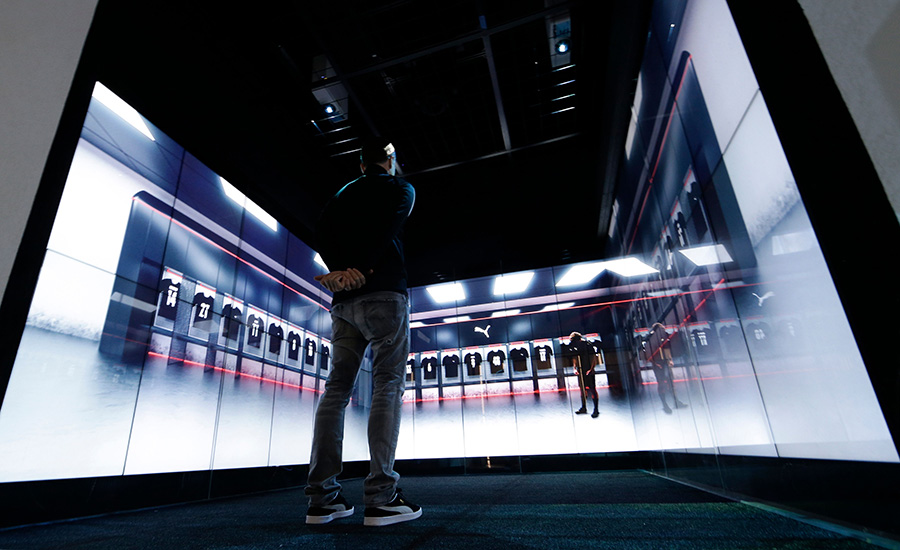
Puma North America CEO, Bob Philion, told SGB that the store serves three purposes. First, he believes there’s a “viable business component” to the location and the brand is aiming to make a profit on the location given the throng of tourists and locals expected to walk by the location every day.
Second is to increase visibility for the Puma brand. The store is part of Puma’s strategy to accelerate growth in North America and represents its “biggest and boldest investment here in North America,” he said.
The location, in particular, is expected to support the brand’s global positioning. Philion said the reason Puma decided to open a flagship now is not only because of the brand’s momentum but because the space opened up. Said Philion, “We feel like it’s the 50-yard line of 5th Avenue. We love the location and the statement that it makes for the brand.”
The store also invites Instagram moments, including selfies with a gargantuan Puma Suede model (red with white-stripe) at the store’s entrance, shown in the lead photo.
Finally, Philion believes operating a massive flagship in the heart of New York City “is going to make us a better company.” Learnings around story-telling, merchandising and the consumer experience are expected to support the wholesale business.
Said Philion, “This store is going to be important for us as a testing ground for things we can do on the wholesale side, which is by far the biggest part of our business. There will be ideas from the customization zone and some of the category and experience zones that we’ll be able to bring to our partners.”
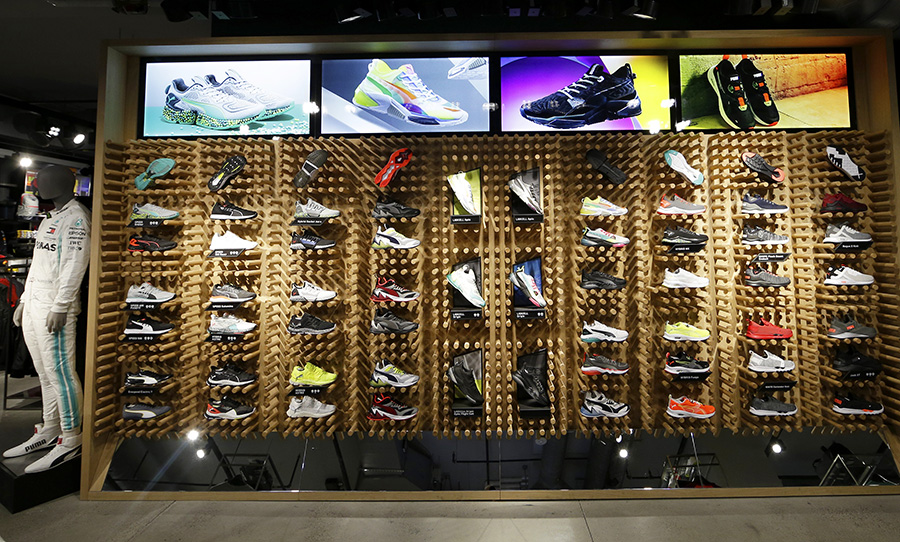
<span style="color: #999999;">The opening comes as Puma’s business has revitalized in North America since Gulden took over in 2013. On a currency-neutral basis, sales grew 16.9 percent in the Americas region in 2018, following gains of 14.3 percent in 2017 and 8.3 percent in 2016. Revenues are running ahead 18.1 percent in the Americas region in the first six months of 2019.
Gulden has committed to reestablishing Puma’s roots in sports, marked by investments in several major soccer clubs as well as the brand’s move last year to reenter the basketball category. But the brand has received the most attention for its collaborations with celebrities including Rihanna, Selena Gomez, Meek Mill, and Nipsey Hussle.
Philion said Puma is clearly benefiting from the ongoing fusion of sport, lifestyle and fashion.
“The consumer right now is definitely in that space and looking for these different influences,” said Philion. “Yes, it starts with sport and we’ve got to have technology and innovation, but we’ve got to also tell the kids something else so this fusion of sports and lifestyle is a sweet spot for Puma.”
Philion said the celebrity hook-ups have been a key driver of Puma’s recent success. He said, “When you play in the world of sport, lifestyle and fashion, you need people to communicate that.”
But he expects the brand will benefit more in the future from the recent signing of many sports stars, particularly many NBA stars. The sports partnerships will also include a lifestyle component.
On sport, he said Puma has developed a strong foothold in golf and basketball. Philion noted, “Those two sports are very North-American centric.” Puma’s strongest presence is in soccer while the brand’s motosports positioning stands out because competitors aren’t in the space.
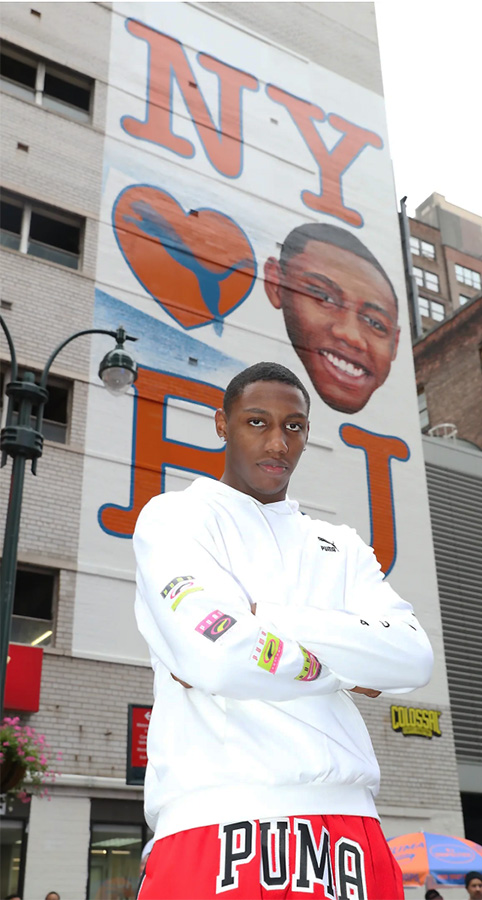 On basketball, Puma on Wednesday announced the signing of RJ Barrett, shown left, who was selected by the New York Knicks as the third pick in the 2019 NBA draft and has been touted as a breakout star. In returning the category, Puma signed five of the top-15 NBA draft picks leading up to the 2018 draft. Other players on Puma’s roster include DeMarcus Cousins, DeAndre Ayton, Marvin Bagley III, Michael Porter Jr., Zhaire Smith, Terry Rozier and Rudy Gay.
On basketball, Puma on Wednesday announced the signing of RJ Barrett, shown left, who was selected by the New York Knicks as the third pick in the 2019 NBA draft and has been touted as a breakout star. In returning the category, Puma signed five of the top-15 NBA draft picks leading up to the 2018 draft. Other players on Puma’s roster include DeMarcus Cousins, DeAndre Ayton, Marvin Bagley III, Michael Porter Jr., Zhaire Smith, Terry Rozier and Rudy Gay.
Philion said Puma’s basketball entry “absolutely checked the box in being disruptive in the space and gaining visibility for the brand.” Philion said Puma is “quite small but growing fast” in basketball, and the sport continues to be seen as a way to tap younger consumers. He said, “It’s got so much lifestyle and culture around it that it’s the perfect sport for the brand, especially here in North America because basketball is really driven by the NBA.”
Some historical details in the store include a large mural of Walt “Clyde” Frazier next to a huge 1973 sign, the year Frazier became the first athlete to come out with a shoe, the Puma Clyde Suede. The store also includes a mural of Ralph Sampson, Puma’s biggest player in the 80s’. The NBA Hall of Famer’s shoe was recently re-released to a strong reception.
Other elements of the store include a coffee shop manned by Birch Coffee, a NYC-based roaster, that is also expected to extend visitors stay to explore the product and experiences.
“I think the biggest thing about the store is that we’ve created an incredibly engaging environment that’s made to build an emotional connection with the brand and the consumer and increase their dwell time,” said Russ Kahn, SVP of retail, Puma North America. “We want to get the consumer to spend more time in the store and really build that relationship with the consumer.”
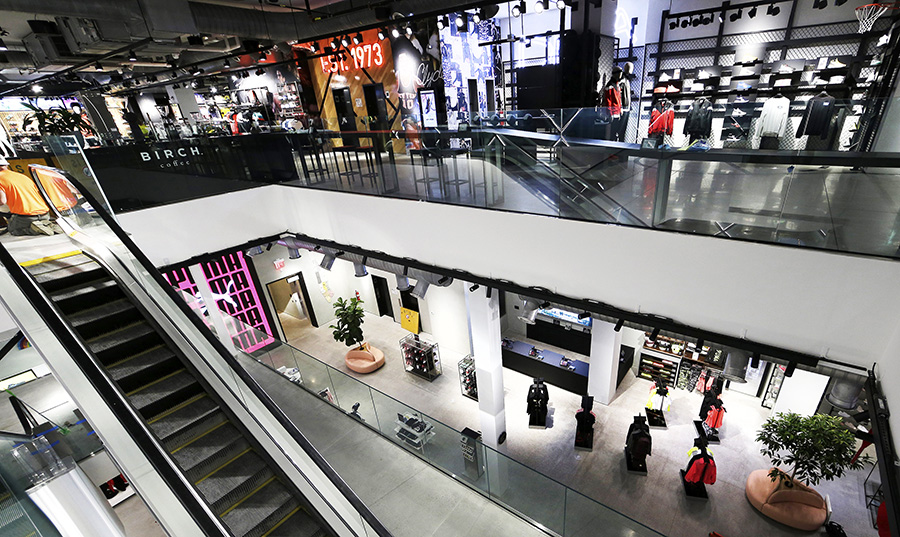
The store has a special section, Puma Select, that showcases exclusive collections designed by select brand ambassadors and athletes. In-store performances, fitness activations and other events are also expected to be regularly hosted at the store.
Kahn said the store was inspired by the iconic Puma Suede sneaker. The design on the outside of the store is meant to mimic the bottom of the Puma Suede. The side of the store features a 23-feet-long neon-rendering of the Puma cat.
Inside, the overall store design embraces Puma’s internal mantra to become “the fastest sports brand in the world.” Said Kahn, “If you look at the design elements, even look at the air conditioning system, it looks sleek, it looks fast, it looks really industrial. It looks like it wants to move.”
Kahn suspects that if the New York flagship proves successful, smaller flagship versions ranging from 5,000 to 7,000 square feet may reach key markets such as Chicago, Los Angeles and Miami.
Philion said much will depend on the New York flagship’s success.
“We’re pioneering a lot here with this store,” said Philion. “But like this location, we’re staying opportunistic for what’s next. We’ve got to get this one right and knock it out of the park in meeting consumer’s expectations, and then I think other doors can flow over time.”
Photos courtesy Puma

